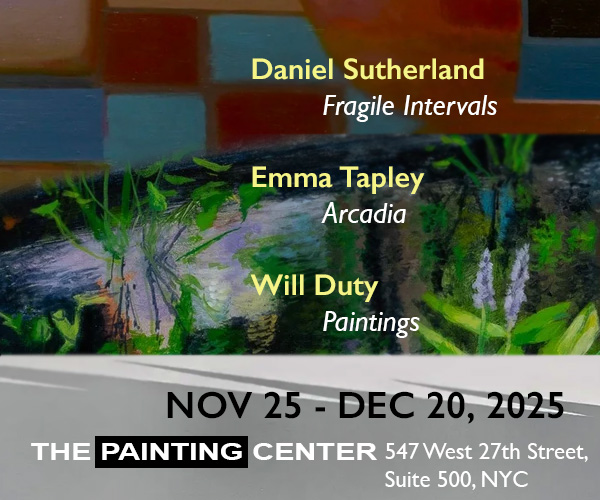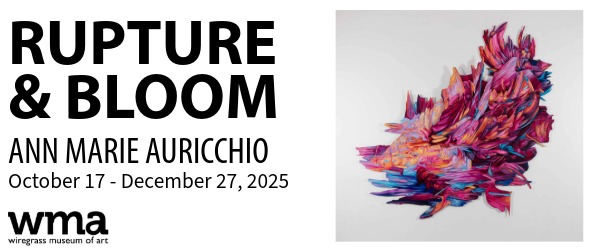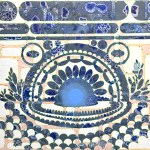
Contributed by Karen Schifano / Reacting to the overtly emotional critical response to Abstract Expressionism, Frank Stella sought to refine Greenbergian formalism by reducing painting to its value as an object and nothing more. He is famous for saying, “What you see is what you see,” and influenced an entire school of art, Minimalism, that grew out of the idea that contextual factors were of “extraneous significance.” This reductive view allowed him to focus sharply on the vocabulary of abstraction. In Minimalism’s wake, Post-Modernism has focused on historical and cultural contexts, the mutability of language, and previously defined categories and canons, offering a more expansive path to meaning in art. Formalism and Minimalism, however, still exert a formidable pull. Painters like Sean Scully, who looks for poetry, metaphor, and emotion in his choices of color, mark making, and paint surface while enveloping the viewer in blocks of stripes, seems to meet both schools of thought halfway. He suggests that while art depends on a formal vocabulary, that is not necessarily the subject matter of the painting. Form can equal content, but it can also host other content.


On these terms, abstract painting remains challenging, and can be downright intimidating. It often carries the mystique of an abstruse process that is too elusive for the average person to intuit, and which must be studied in order to understand the work. Many viewers feel compelled to ask the question “What is it?” and to seek an explanatory narrative. But there’s a case to be made that if they were to drop all attempts at verbally expressible, intellectual analysis and stand directly in front of almost any abstract painting, yielding to the visual moment, they would formulate powerful responses that, upon reflection, would help them discern what pleases, creates anxiety, and feels solid or unstable about a painting. In short, the perception of form triggers emotional responses that help people understand how they think and feel.

The group exhibition “Side to Side, Three Ways” at Trestle Art Space — presenting the work of Emily Berger, Kim Uchiyama, and Manel Lledos, and curated by Key Projects — seems to validate Scully’s reconciliation of the Minimalist and Post-Modernist viewpoints. Their paintings employ illusions of physical structure: bands that run from side to side and from top to bottom, mimicking architecture, landscape, textile, or text. Some of the canvases are large enough to seem life-size. The viewer, as a vertically oriented creature, feels the gravity implicit in the compositions, as well as the musical rhythms of the repetition of shapes. Compositions can be absorbed holistically, in one go, or metaphorically read as text, from left to right, right to left, top to bottom. Both ways of seeing can make sense, depending on whether the viewer see herself as immersed in the picture plane, darting in and out of illusory space, or watching calmly from a distance.

The artists sometimes do draw on real-world influences. Kim Uchiyama’s work derives an informed experience of form and color, influenced by the architecture of ancient Greece. She says:
The works are based on the earth, sea, and sky of ancient Greece as filtered by my modernist influences. The presence of Greek temples and their situation within their surrounding landscapes impressed me deeply when I visited them. Theatrical and dramatic, the geometry of the temples directly contrasts undulating, earthbound settings. I felt both material weight and the weight of history from these sites.

Abstractly conveying the heft and mass of the temples, Uchiyama also imparts a sense of ascending from grounded forms through brilliant sky and sunlight. Each large horizontal stripe is bounded on either side by lighter and thinner strips of neutral color. The rhythm of light and dark lets the main color be appreciated in full, alongside dusty ochres, earthy browns, blues, burnt reds and olive greens that conjure underlying light, heat, and stone.
By contrast, the bands of color in Manel Lledos’s work consist of curved edges that suddenly and unexpectedly interrupt the flow of the composition, like the impingement of another boundary. The curves seem to “embrace” the painting periodically, and Lleds speaks of fashioning an unstable space somewhere between near and far as a metaphor for his own life. Unlike the other two artists in the show, Lleds employs a square format for his painting, flatly applying bright colors with neutrals or white in alternating bands, so that his compositions tend to read as signs rather than structures. The paintings have a jazzy, Stuart Davis-like feel, inspiring momentary pleasure but also the unease of ceaseless change.

Emily Berger works within the AbEx tradition, gesturally repeating striations of sumptuous color. Unlike Uchiyama and Lleds, she allows her long horizontal edges to soften, break apart, ripple and coalesce in lines that can be off-kilter, scraped-through, and uneven. The horizontal lines sometimes show evidence of gravity, as if her arm moved naturally in a downward curve to the center of the panel, serving to control the short, choppy, vertical gestures that insouciantly “write” their way across the surface within the bands of color, conveying the tension between structure and liberation, logic and emotion. Her resonant blacks and blues are dark and brooding, her yellows more lyrical and cheerful. Wood grain shows through sometimes, revealing the materiality of the support and setting off the color of the thicker painterly marks. Thus, Berger’s paintings themselves reflect her endeavor to “find the painting.”
Each of the three artists in “Side to Side” reveals his or her unique sensibility in an abstract language that viewers can decipher emotionally and pin down intellectually. What you see certainly is what you see, but a little more as well.
“Side to Side, Three Ways,” curated by Key Projects, at Trestle Art Space, 850 3rd Avenue, Suite 411, Sunset Park, Brooklyn, NY. Through October 25, 2020. An earlier version of this essay was written to accompany the exhibition.
About the author: Karen Schifano is an abstract painter and art restorer. Her work was recently featured in Lula Japan, Issue #7, and New American Painting, #134, Northeast Edition. In 2018 she was elected to membership in American Abstract Artists.
Related posts:
Frank Stella’s hard-edge sfumato
IMAGES: Karen Schifano
Facebook IRL
Effects of chance: A conversation with Emily Berger























Enjoyed this review. Sorry to find it so randomly after the fact of the exhibit. Plain speak about abstraction in painting os so much needed I hope you continue to write reviews and hopefully I can spread the circulation of them in a more timely manner. Sharing now to FB anyway.